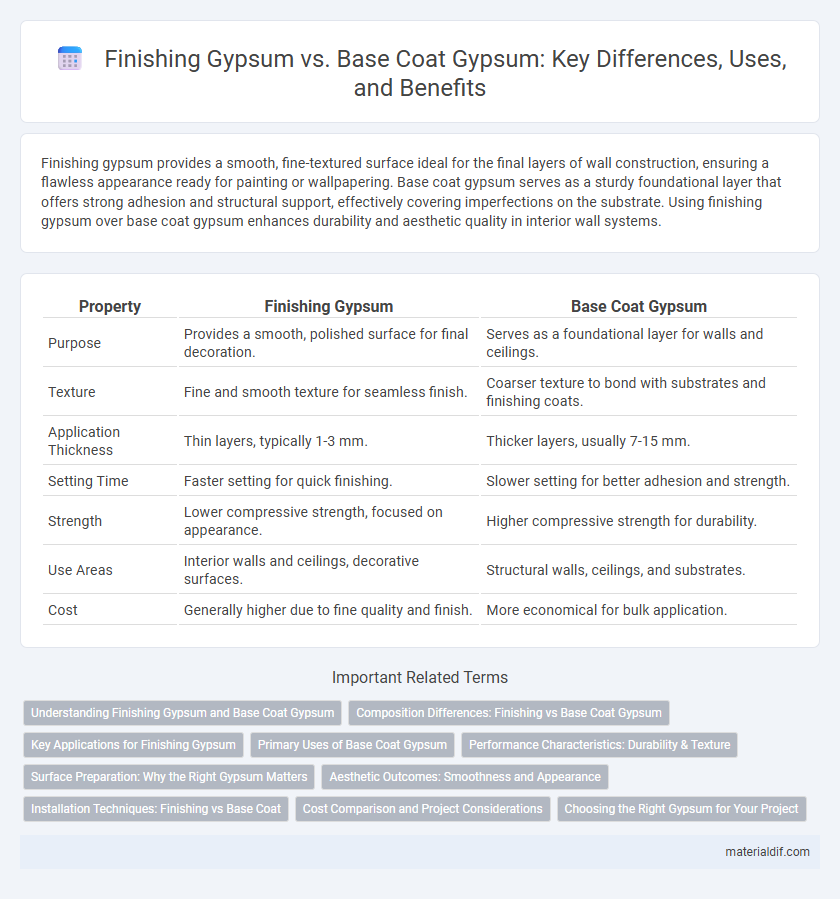Finishing gypsum provides a smooth, fine-textured surface ideal for the final layers of wall construction, ensuring a flawless appearance ready for painting or wallpapering. Base coat gypsum serves as a sturdy foundational layer that offers strong adhesion and structural support, effectively covering imperfections on the substrate. Using finishing gypsum over base coat gypsum enhances durability and aesthetic quality in interior wall systems.
Table of Comparison
| Property | Finishing Gypsum | Base Coat Gypsum |
|---|---|---|
| Purpose | Provides a smooth, polished surface for final decoration. | Serves as a foundational layer for walls and ceilings. |
| Texture | Fine and smooth texture for seamless finish. | Coarser texture to bond with substrates and finishing coats. |
| Application Thickness | Thin layers, typically 1-3 mm. | Thicker layers, usually 7-15 mm. |
| Setting Time | Faster setting for quick finishing. | Slower setting for better adhesion and strength. |
| Strength | Lower compressive strength, focused on appearance. | Higher compressive strength for durability. |
| Use Areas | Interior walls and ceilings, decorative surfaces. | Structural walls, ceilings, and substrates. |
| Cost | Generally higher due to fine quality and finish. | More economical for bulk application. |
Understanding Finishing Gypsum and Base Coat Gypsum
Finishing gypsum offers a smooth, dense texture ideal for final surface layers, ensuring a polished appearance and excellent paint adhesion. Base coat gypsum provides a rougher, more porous structure designed for strong adherence to underlying substrates and serving as a foundational layer for successive finishes. Understanding the difference in composition and application ensures optimal layering in plastering systems for durability and aesthetics.
Composition Differences: Finishing vs Base Coat Gypsum
Finishing gypsum typically contains finer, more refined particles and additives like retarders and plasticizers to enhance smoothness and workability, while base coat gypsum features coarser aggregates for better adhesion and structural support. The composition of finishing gypsum prioritizes a smooth, polished surface, whereas base coat gypsum is formulated for durability and strength as the foundational layer. These differences in formulation directly impact drying time, texture, and application techniques.
Key Applications for Finishing Gypsum
Finishing gypsum is primarily used for smooth, final surface finishes on walls and ceilings, providing an ideal base for paint or wallpaper application. Key applications include skim coating, decorative moldings, and creating seamless joints in interior construction. This type of gypsum ensures a refined, aesthetically pleasing appearance with enhanced durability and resistance to cracking.
Primary Uses of Base Coat Gypsum
Base coat gypsum serves as the foundational layer in wall construction, providing structural support and adhesion for subsequent finishing layers. It is primarily used to create a smooth, even surface for finishing gypsum applications, ensuring durability and resistance to cracking. Commonly applied in interior walls and ceilings, base coat gypsum enhances the stability and longevity of plaster systems.
Performance Characteristics: Durability & Texture
Finishing gypsum offers a smooth, refined texture ideal for final surface treatments, while base coat gypsum provides a coarser texture designed for strong adhesion and structural support. Durability of finishing gypsum lies in its resistance to cracking and ease of sanding, making it suitable for cosmetic applications, whereas base coat gypsum excels in impact resistance and moisture tolerance. Both types contribute to overall wall system stability, with finishing gypsum enhancing aesthetic quality and base coat gypsum ensuring foundational strength.
Surface Preparation: Why the Right Gypsum Matters
Finishing gypsum provides a smooth, polished surface ideal for painting or wallpapering, whereas base coat gypsum offers a rougher texture designed for better adhesion of subsequent layers. Proper surface preparation requires selecting the right gypsum type to ensure durability and optimal bonding between coats. Using the appropriate gypsum reduces cracking, enhances finish quality, and supports long-lasting wall integrity.
Aesthetic Outcomes: Smoothness and Appearance
Finishing gypsum provides a smoother, more refined surface crucial for high-quality aesthetic outcomes, creating a uniform appearance ideal for paint or wallpaper application. Base coat gypsum, while offering structural stability and excellent adhesion, has a coarser texture that requires additional finishing layers to achieve desired smoothness. The choice between finishing and base coat gypsum directly impacts the visual appeal and surface preparation quality of interior walls and ceilings.
Installation Techniques: Finishing vs Base Coat
Finishing gypsum requires a smoother, finer application using trowels and sanding tools to achieve a seamless surface ideal for painting or wallpapering, whereas base coat gypsum involves a thicker, rougher layer applied with hawks and trowels to provide structural support and adhesion. Installation techniques for finishing gypsum emphasize precision and uniformity to minimize surface imperfections, while base coat gypsum prioritizes durability and adherence to the substrate. Proper curing times and controlled moisture levels are critical during installation to ensure optimal bonding and longevity for both gypsum types.
Cost Comparison and Project Considerations
Finishing gypsum typically incurs higher costs than base coat gypsum due to its finer texture and labor-intensive application process, which demands skilled craftsmanship for a smooth, paint-ready surface. Base coat gypsum offers cost efficiency by serving as a structural layer that requires less precision and materials, making it ideal for large-scale projects with budget constraints. Project considerations must weigh the balance between upfront material and labor costs of finishing gypsum against the functional benefits and savings of using base coat gypsum as an underlayer.
Choosing the Right Gypsum for Your Project
Finishing gypsum provides a smooth, paint-ready surface ideal for visible areas, while base coat gypsum offers enhanced strength and better adhesion for underlying layers. Selecting the right gypsum depends on project requirements such as durability, finish quality, and moisture resistance, with finishing gypsum suited for interior decorative work and base coat gypsum preferred for structural support. Understanding these differences ensures optimal performance and longevity in drywall installations.
Finishing gypsum vs Base coat gypsum Infographic

 materialdif.com
materialdif.com